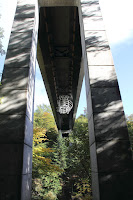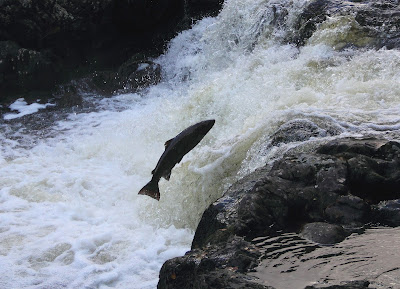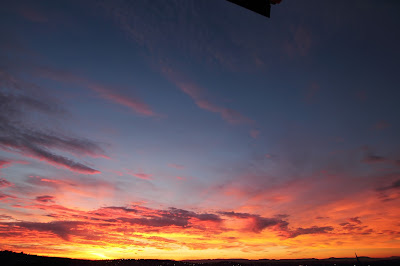Saturday, October 31, 2015
Friday, October 30, 2015
Wednesday, October 28, 2015
Tuesday, October 27, 2015
Saturday, October 24, 2015
Book Notes: From the Holy Mountain by William Dalrymple
"From the Holy Mountain" is not just an unusual book, it is by any measure, an extraordinary one. The author, William Dalrymple strides through history, politics, memoir, interviews, satire and theology with some style, with all these strands flowing from a travel diary.
In 578AD, a Monk named John Moschos toured the Levant, at a time when The Byzantine Empire was in its last years of decline across the Middle East. This formally "christian" state, was starting to crumble as Moschos explored it, due to internal disintegration and external threats. The lands he traversed would fall first to The Persians, and then Islamic Armies. Moschos' work The Spiritual Meadow, recorded his research, notably of the hugely varied Christian communities (both Orthodox and heretical), he visited. The Middle East was then burgeoning with monastic communities of Copts, Syrian and Greek Orthodox, Palestinians and others.
In the 1994, William Dalrymple set out to retrace Moschos' remarkable journey through Greece, Turkey, Syria, Israel-Palestine and Egypt. His journey took him to many of the sites that are described in The Spiritual Meadow. Some of the places which Moschos described are completely lost today, long-forgotten Monasteries or Churches buried below Israeli dual-carriageways, for example. Others are ruins or archaeological sites, wind-blown desert sites where the remaining stones are used to corral sheep. In many of the places he explored still had living Christian communities in 1994, in some instances, the same monastic communities using the same music and liturgies that Moschos describes from the late 570s. In one or two instances, Dalrymple speaks to the very last inhabitants of these ancient communities which are steadily dying out.
Dalrymple writes:
The Christian population that Moschos knew and wrote about - the monks and the stylites, the merchants and soldiers, the prostitutes and the robber chiefs - all the strange and eccentric characters who wander in and out of The Spiritual Meadow, were conquered and subjugated, their numbers gradually whittled down by emigration, intermarriage, and mass apostasy.... [in a] process that has persisted ever since, greatly accelerating in this century. It is a historical continuum that began during the journeys of Moschos and the final chapter of which I have been witnessing on my own travels some fourteen hundred years later. Christianity is an Eastern religion which grew firmly rooted in the intellectual ferment of the Middle East. John Moschos saw that plant begin to wither in the hot winds of change that scoured the Levant of his day. On my journey in his footsteps I have seen the very last stalks in the process of being uprooted. (p453)And summarizes:
But if the pattern of Christian suffering was more complex than I could possibly have imagined at the beginning of this journey, it was also more desperate. In Turkey and Palestine, the extinction of the descendants of John Moschos' Byzantine Christians seemed imminent; at current emigration rates, it was unlikely that either community would still be in existence in twenty years. In Lebanon and Egypt the sheer number of Christians ensured a longer presence, albeit with ever-decreasing influence. Only in Syria had I seen the Christian population looking happy and confident, and even their future looked decidedly uncertain, with most expecting a major backlash as soon as Asad's repressive minority regime began to crumble. (p448)
In the light of what has unfolded in Syria over the last two years, this makes even more grim reading. Earlier in the book, I read with surprise, and a slight feeling of nausea when Dalrymple described his longing to escape from repressive Turkey into the relative freedom of Syria. The extinction of these old Christian communities which he caught the last glimpses of in 1994 - is now almost complete in many of the places he visited. From the Holy Mountain, may have been a wonderful piece of travel writing in 1994, but it now appears as a timely and invaluable historical document.
I have though done a dis-service to the book by quoting those two paragraphs though! Not, because they are in any way unworthy of quoting, but rather because they are very unrepresentative of the tone of the whole. These two more analytical quotes are very much the exception in a long book which is mostly anecdotes, stories, and adventures in unlikely places, interacting with a panoply of characters to amaze, delight and appal the reader in equal measure. From the Holy Mountain, like all the best travel writing, has the sense that the places and the people have left a deep imprint in the author - who is a good enough writer to pass that impression on to the reader. In turns it is insightful, educational, witty, exciting, bizarre, hilarious and then deeply and troublingly melancholy, From the Holy Mountain is a snapshot from the 1990s of one of the great tragedies of our age - the displacement of the Middle East's ancient Christian populations from their lands.
Wednesday, October 14, 2015
Lochs, Rivers, Bridges and Leaping Salmon - The Faskally Circuit
Despite the beautiful autumnal sunshine, clear weather forecast and almost perfectly still air, we didn't head for the high mountains. Sadly, my wife is carrying a bit of an injury to her right shin/ankle which seems to get aggravated by hard walking. Instead, we went to Pitlochry and walked the paths and roads which form a circuit of Loch Faskally and its two main feeding rivers, The Tummel and The Garry.
The Car Park near Pitlochry Station has a road which leads under the tracks and down towards the Hydro-Electric dam, which is one of the town's most well known features. The dam, which blocked the River Tummel just after WWII, created Loch Faskally, and provides 15MW of power for the National Grid. While some artificial lochs look very artificial, Faskally has a remarkably natural feel to it, given how short a period of time it has been part of the landscape. It is also home to a network of easily navigable waymarked paths which form pleasant and undemanding walking routes.
We struck Northwards up the East side of the loch. The route begins on a shore-hugging footpath, then diverts around some housing and picks up a minor road out to a boat club. Here, the town is left behind and the lochside path, decked in autumn colours is delightful.
The first landmark in the route is the bridge which takes the A9 trunk road high over the loch. Its amazing to think that until 1981, all the North-South traffic between The Central Belt and The Highlands was funnelled through Pitlochry High Street on the old A9. My Grandparents regularly drove (or moped-ed) the old A9, on their highland holidays, which often began with a Motorail journey through England - which itself had no complete motorway network in those days. The queues in Pitlochry High Street in the summer must have been demoralising for tourists and locals alike. These days the A9 is slewed across the glen and back, and Pitlochry is but a series of roofs and spires on the far side, as far as most travellers are concerned. The only negative aspect of this is that the railway line has not been upgraded over the years in which untold millions has been spent on (and is continuing to be spent on) the A9. That, and the fact that most travellers to the North are carried high above the lovely lochs, woods and rivers that surround Pitlochry, which are simply not visible from the tarmac and crash-barriers. Looking up from under the A9 bridge over which we have driven maybe hundreds of times, we realised what we had been missing!
Immediately under the A9 bridge, a footbridge crosses the river, we didn't cross it, but continued up the East
side of the Tummel - that bridge would be part of our return route, and the last in a series of remarkable and dramatic footbridges which have been hurled across the rivers here. The path follows the bank of the river, past the confluence of the Tummel and The Garry and the majestic Faskally House. eventually passing under the soaring bridge of the Loch Rannoch, Rannoch Station and Rannoch Moor road. Nearly a quarter of a century ago my wife and I drove over along that road on one of our first dates; today we walked under it with two of our three children, while our oldest (who earlier in the day received confirmation that he is entered on the electoral role and vote in the Scottish elections next year), stayed at home to revise for his exams: tempus fugit!
 A few hundred yards past the high road bridge, an amazing footbridge crosses the river. A path continues to Killiecrankie, but time prevented us from going further, and we crossed to begin our return walk down the west side of the river and loch. Crossing the bridge, my wife realised that she had seen this view before - but wasn't sure where. Suddenly she unearthed a memory.... these bridges in the Pass of Killiecrankie had been on the cover of the University of Dundee 1990 Prospectus which she had received prior to going there to read medicine. It turned out that this was a walk she had been intending to do since then!
A few hundred yards past the high road bridge, an amazing footbridge crosses the river. A path continues to Killiecrankie, but time prevented us from going further, and we crossed to begin our return walk down the west side of the river and loch. Crossing the bridge, my wife realised that she had seen this view before - but wasn't sure where. Suddenly she unearthed a memory.... these bridges in the Pass of Killiecrankie had been on the cover of the University of Dundee 1990 Prospectus which she had received prior to going there to read medicine. It turned out that this was a walk she had been intending to do since then!
The path back down the west side of the Garry is charming, with open fields and farms complementing the fast-flowing torrent now on the left. The return walk is longer than the outward leg, as the River Tummel, joining the Garry from the West, presents an uncross-able obstacle at the confluence. A diversion of a mile or two up the Tummel to another (wonderful) footbridge is required in order to resume southward progress. This however is no bad thing, as the excursion up the Linn of Tummel is one of the highlights of the walk. As we were there, the waters were crashing over the rocks, with Salmon hurling themselves into the fray in their annual upriver migration. It would be worth coming our here for this alone!
Once over the Tummel, the route joins an unclassified road which runs behind the Clunie power station, and on to the first footbridge by the A9 road, and the completion of the circuit. All that remains is a gentle plod along the side of Loch Faskally back to Pitlochry - and the inevitable coffee shop visit before the drive home. This may not have been an epic mountain day, and McNeish might be optimistic in calling this one of "Scotland's 100 Greatest Walks", but it is a charming and delightful place, full of interest and beauty, perfect for a Winter walk, or to enjoy in autumn colours.
Labels:
Hills,
Landscape,
Marriage,
Parenting,
Photography
A90 Trails
Still learning (teaching myself) how to do these.... having fun with it and have a few ideas of things to adjust for next time.
Book Notes: The Seventies Unplugged - A Kaleidoscopic Look At A Violent Decade by Gerard DeGroot
The Seventies Unplugged is the follow-up to DeGroot's highly entertaining and thoughtful book about The Sixties (also billed as a decade 'unplugged'). The book is laid out in a similar format, written as a series of stand-alone historical essays which inform the reader and debunk popular historical myths and misunderstandings along the way.
The Sixties Unplugged is a much funnier book than the second book in the series. Then again, there seemed to be more to laugh about in the debunking of hippie cults who thought that their various rituals would contribute to world peace, than to the more grimy decade which followed. Here in this volume, DeGroot takes the reader on something of a whistle stop tour through a decade which included Charles Manson, the Baader-Meinhof Gang, The Oil Crisis, The Killing Fields of Cambodia, the psychotic antics of Idi Amin, the revolutionary fervour of Islamic Iran, disasters in Vietnam, Arab-Israeli wars, and peace processes, race-riots, the resurgent right wing, skinheads and racists, and punk rock. DeGroot's book is not however about re-stating historical stereotypes which carve the progress of history into neat decade-long compartments. He is conscious to avoid the obvious error of painting the Sixties just in the psychedelic colours of peace and love (when it was in many ways quite conservative), and the Seventies as only a series of atrocities. The one dissapointment of this one is that the arsenal of stunning and surprising quotations which lit up virtually every chapter of 'the Sixties; were largely absent from 'The Seventies'.
The essays which make up the book are not just journalistic pen-portraits sketching events however. DeGroot is a serious historian who has taken much care in both the selection of issues to cover, and in researching them too. He isn't afraid to offer his own distinctive interpretation of events either, even when the subjects are as controversial as the American arming of the Mujahedeen in Afghanistan, or Bloody Sunday and the start of 'The Troubles' in Northern Ireland.
What emerges from all this is a fascinating book, which makes deeply informative, if not rather sobering, reading. For me, the 1970s involved a quiet, safe, suburban childhood; yet if I had travelled far in any direction I would have stumbled into the significant cultural, political, military and disturbing events which DeGroot explains so well in this compelling volume. Some of the chapters covered subjects I knew fairly well (such as the rise of Margaret Thatcher, or the tragedy of the Jonestown mass suicides); while other chapters introduced me to important subjects about which I was shamefully ignorant. These included, the 1972 Munich Olympic Games, The fall of Salvador Allende in Chile, The Camp David Accords, the entertaining marriage advice offered by Marabel Morgan, or the development of the first IVF treatments and 'test tube babies'.
At well over five hundred pages, it is not a short read, but it isn't a hard going, in that DeGroot wears his thorough scholarship lightly - not hiding his meaning behind obtuse academic lingo, or weighing the text down with unnecessary references which are all buried in the extensive footnotes. I wonder if DeGroot has started work on a Kaleidoscopic history of the 80s yet!?
Monday, October 12, 2015
Sunday, October 04, 2015
Thursday, October 01, 2015
Perth Sunsets Gallery
No filters, no enhanced or boosted saturation. These sunsets are all straight from the camera. Click on any image to enlarge.
Subscribe to:
Comments (Atom)











































